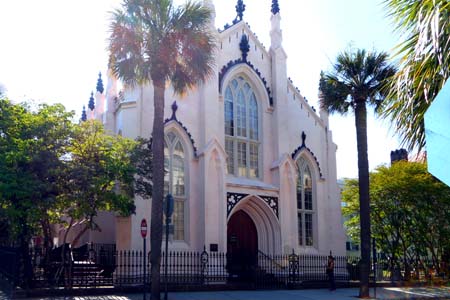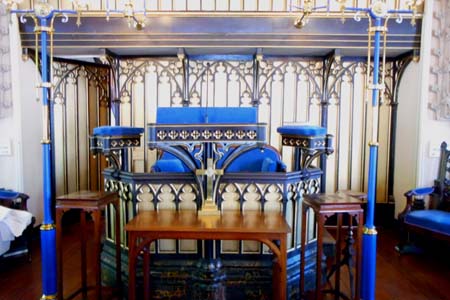| |
 |
 |
 |
| Comment on this report, or find other reports. |
 |
| Our Mystery Worshippers are volunteers who warm church pews for us around the world. If you'd like to become a Mystery Worshipper, start here. |
 |
| Find out how to reproduce this report in your church magazine or website. |
|
|
| 3180: French Protestant (Huguenot) Church, Charleston, South Carolina, USA |
 |
 |
 |
Mystery Worshipper: Paterfamilias.
The church: French Protestant (Huguenot) Church, Charleston, South Carolina, USA.
Denomination: Independent. Huguenots are French Protestants, Calvinist in theology, who trace their origins back to the earliest years of the Reformation. Granted freedom of worship by the Edict of Nantes in 1598, they were nevertheless increasingly persecuted as the 17th century wore on, culminating in revocation of the Edict of Nantes in 1685. Many fled to England and the American colonies. By the late 17th century there were four groups of Huguenots in South Carolina, each with its own church. But they assimilated quickly, with three communities becoming parishes in the Church of England (the established church in South Carolina as of 1706), though not without some resistance to Anglican liturgical practice. Only the French Church in Charleston maintained its autonomy and Huguenot identity.
The building: It dates from 1844 and is the work of Edward Brickell White, a prominent South Carolina architect who designed a number of churches both in Charleston and in other South Carolina cities. The French Church is the oldest Gothic Revival church in South Carolina. There are gated pews. On the side walls are mural tablets in commemoration of famous Huguenot personages, including Presidents of the United States. There is a large pulpit, centered, with a relatively small communion table in front of it. On the wall behind the pulpit, on either side, are large tablets with the Ten Commandments.
The church: Founded in 1680 by the first wave of Huguenot refugees, the parish closed in 1823, and was then revived in 1844. But it had become a parish whose survival depended upon the endowments of the departed rather than any active participation of the living. For most of the 20th century it was not an active parish, but it did host annual commemorative services, weddings, and musical presentations. An active congregation was reestablished in 1983, and the French Church is now the only Huguenot parish in North America. They have a close relationship with the Huguenot Society of South Carolina, which houses the parish's records. Services are held each Sunday in English using the liturgy contained in The Liturgy of the French Protestant Church, translated in 1836 from the editions of 1737 and 1772 published at Neufchatel and Vallangin. Communion is held on the first Sunday of each month.
The neighborhood: On the Atlantic coast in northern South Carolina, Charleston was founded in 1670 as “Charles Town” in honor of King Charles II. By 1690 it had become the fifth largest city in the American colonies. It is the oldest, and second-largest, city in South Carolina. Each spring the city hosts the Spoleto Festival USA, featuring cutting-edge performances in classical music, jazz, theatre, and dance. The French Church is in the city's historic French Quarter, with well-preserved architecture, beautiful historic homes, and world-class restaurants. Directly across the street from the French Church is the Dock Street Theatre, the first building in North America to be built solely for theatrical performances. Just a block north is St Philip's Church, formerly an Episcopal church. (St Philip's is a parish in the Diocese of South Carolina, which in 2012 voted to withdraw from The Episcopal Church and communion with Canterbury.) Many Huguenots became members of St Philip's while still financially supporting the French Church. This area of Charleston is within easy walking distance of the Atlantic Ocean.
The cast: The Revd Phillip C. Bryant, pastor, presided at the baptismal service. The Revd Thomas Guerry, associate pastor, preached and presided at the liturgy of the Holy Supper. The two ministers were vested in black robe, ruff, and red stole. Tray Stephenson served as organist and choirmaster; Niel Hatcher played the organ prelude. Philip Claypool was lector.
The date & time: Pentecost Sunday, June 4, 2017, 10.30am.
What was the name of the service?
Morning Service for the Lord's Day. Included within the service were the Liturgy of Baptism of Keller Crane Thompson and the Liturgy of the Holy Supper.
How full was the building?
About two-thirds full in a building I estimate would seat 200-250 (I'm not quite sure how large the balcony is).
Did anyone welcome you personally?
Two ushers were in front of the church as I approached. One greeted me with "Bonjour, monsieur" as he handed me a bulletin.
Was your pew comfortable?
Not altogether; little arch in the back. There were kneelers under the pew in front of me, but we did not kneel in this service.
How would you describe the pre-service
atmosphere?
Quite chatty, the conversations extending into Mr Hatcher's prelude.
What were the exact opening words of the
service?
"Our help is in the name of the Lord, who made heaven and earth." This followed a sung introit, "May the Grace of Christ Our Saviour" by John Stainer.
What books did the congregation use during the
service?
The Liturgy, or Forms of Divine Service, of the French Protestant Church of Charleston, S.C. and The Huguenot Hymnal. The Huguenot Hymnal Supplement was also available but not used in this service. All three of these books are unique to this parish. There was also a King James translation of the Bible, but it was not used.
What musical instruments were played?
Two organs, one in the front of the church behind the pulpit area, and a second (electronic) in the rear gallery. The organ in front was installed when the church was built, and was designed by the famed organ builder Henry Erben; there were various emendations in 1929, 1969, and 1984, and an extensive renovation by Knowlton Organ Co. (Davidson, NC) in 1997. The Erben was used only for the prelude.

Did anything distract you?
All of the conversation going on during the prelude.
Was the worship stiff-upper-lip, happy clappy, or
what?
A formal liturgy, taken from the prayer book noted above, but with no more ceremonial than one would expect in a parish with a strong Calvinist heritage. These folks are serious about using this liturgy – it's rather wordy in an 18th century sort of way, and they allow themselves to omit bits and pieces, but the book is mandated for use. The possibility of amending it is allowed, but it's never happened. The liturgy of the Holy Supper was interesting: a preface (but without the dialogue that in most Western liturgies precedes it) leading into the Sanctus; the Lord's Prayer and other intercessions; a confession; and then the consecration of the bread and cup. Pastor Guerry spoken the words of institution facing the table, while Pastor Bryant stood facing the congregation holding first a paten with hosts, and then the chalice. Pastor Bryant communed himself and then administered the sacrament to Pastor Guerry. The congregation received at the rail; we could take either wine from a chalice, wine from a small individual cup, or grape juice from an individual cup. The prayer book calls for the Gloria in Excelsis to be sung after communion, but at this service two verses of "America" (to the tune Brits know as "God Save the Queen") were sung in its stead.
Exactly how long was the sermon?
9 minutes.
On a scale of 1-10, how good was the preacher?
10 – Associate Pastor Guerry is an accomplished public speaker with an engaging sense of humor. While speaking of the Tower of Babel, he noted his fear of heights, and he said that he has a friend who does not fly because he is convinced that Jesus said to the Apostles: "Low, I am with you."

In a nutshell, what was the sermon
about?
First, he said that this is the only day in the church year that red is worn. Then he compared the account of Pentecost in the book of Acts with the story in the book of Genesis about the Tower of Babel. The pride of the people who wanted to build a tower reaching into the heavens caused God to confuse the languages of the people. Babel is a warning of the overreach of human pride. On the day of Pentecost, the Holy Spirit overcame divisions of land and language.
Which part of the service was like being in
heaven?
Being in this beautiful space, recalling the persecution earlier generations of Huguenots endured. The baptism was also a joy to witness. The candidate was a child of about four or five; he was represented by godparents who were called "sponsors." No mention of banishing the devil, but we prayed that God would "receive this child into the covenant of thy mercy and make him a partaker of thy grace." Both the sponsors and birth parents were asked to "promise before God and this assembly ... to exhort this child ... to the end that his whole life may be employed for the glory of God, and for the edification of his neighbor." Baptism was by sprinking, not by immersion, and there was no chrismation nor traditional white garment.
And which part was like being in... er... the other place?
Walking from my hotel to the church in Charleston's horrific humidity. I would hate to think what it's like in August.
What happened when you hung around after the service looking lost?
Nothing.
How would you describe the after-service
coffee?
There was none. Most Sundays, there is a collation (a light meal) with wine, but I gather that no one had signed up to host one for this Sunday.
How would you feel about making this church your regular (where 10 = ecstatic, 0 = terminal)?
N/A – There is a whiff of the museum about this 18th century liturgy that does not appeal to me. Preaching was excellent, the music was quite nicely done. I suppose I would say that what the French Church strives to do, it does very well.
Did the service make you feel glad to be a
Christian?
Yes.

What one thing will you remember about all this in seven days' time?
The way the consecration of the bread and wine was done. |
|
|
 |
 |
 |
| We rely on voluntary donations to stay online. If you're a regular visitor to Ship of Fools, please consider supporting us. |
 |
 |
 |
| The Mystery Pilgrim |
 |
| One of our most seasoned reporters makes the Camino pilgrimage to Santiago de Compostela in Spain. Read here. |
 |
 |
 |
| London churches |
 |
| Read reports from 70 London churches, visited by a small army of Mystery Worshippers on one single Sunday. Read here. |
| |
|
|
|
|


